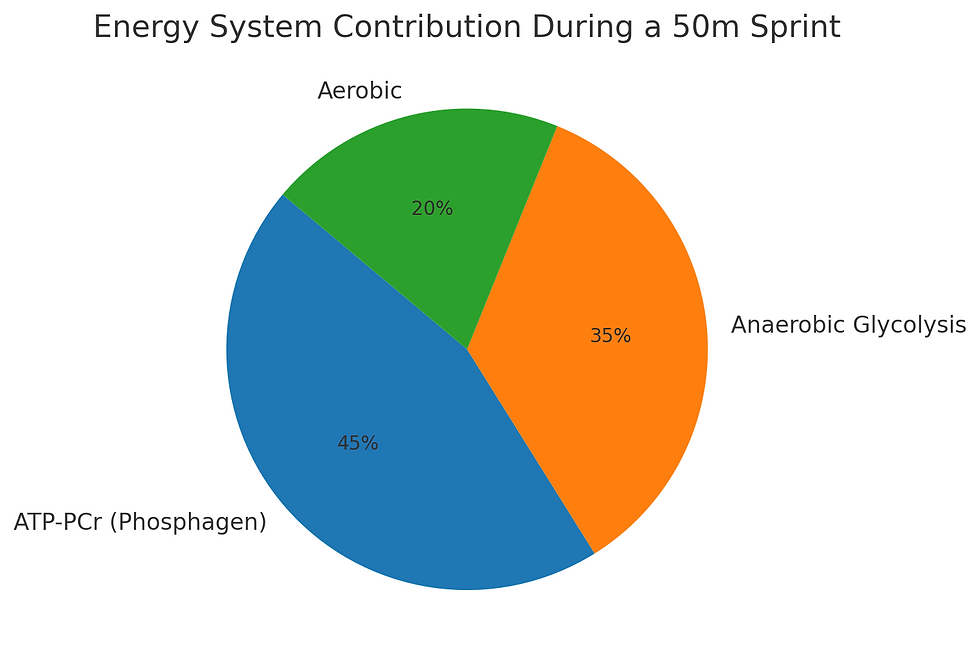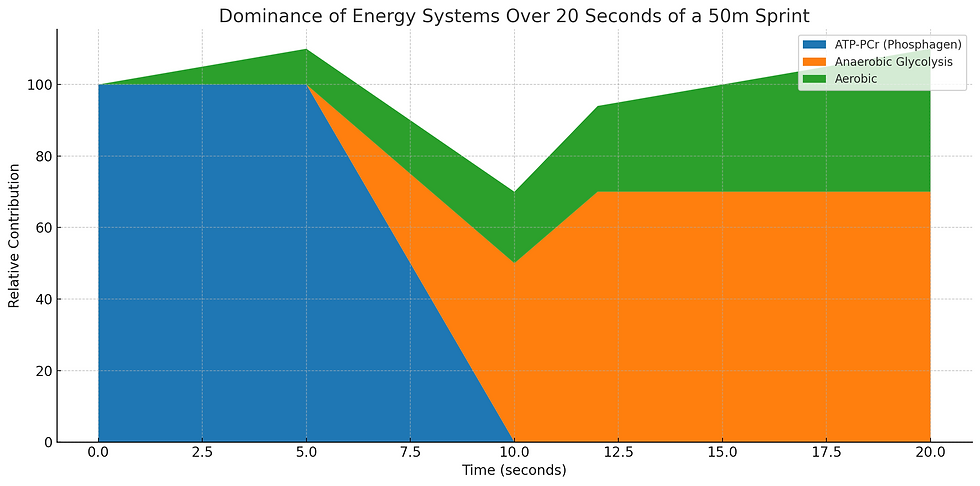What Powers a 20-Second Swim? The Science of Sprint Energy
- Omar Ahmed Elewa
- Jun 3
- 2 min read
A 20-second swim isn’t just about fast arms and strong legs. It’s a full-body biochemical explosion. The 50m freestyle is over in the blink of an eye, but under the surface, three energy systems are firing at full capacity to propel the swimmer through the water. This post dives into the science of how elite sprinters generate and manage energy when there’s no time to breathe, no margin for error, and no room for fatigue.
The Three Systems Behind a 20-Second Sprint

Elite swimmers tap into three core energy systems during the 50m freestyle:
ATP-PCr System (Alactic Anaerobic)
Dominates the first 5–8 seconds.
Uses phosphocreatine to rapidly regenerate ATP (energy), allowing for explosive movement.
Powers the dive, dolphin kicks, and initial strokes.
Anaerobic Glycolysis (Lactic Anaerobic)
Kicks in after 5–8 seconds.
Breaks down stored glucose without oxygen, producing high amounts of energy—and lactic acid.
Fuels most of the swim, especially the final 25m.
Aerobic System
Supports only ~20% of total effort during the race itself.
Plays a major role in recovery between heats and in maintaining training capacity.
Breakdown of Energy Contribution in a 50m Sprint:

ATP-PCr: 45%
Anaerobic Glycolysis: 35%
Aerobic: 20%
What Makes Anaerobic Power the King of Sprinting?
To swim at 2.5 meters per second, you need:
Maximum force from fast-twitch muscle fibers
High phosphocreatine stores to power the initial burst
Efficient lactate buffering to delay fatigue from glycolysis
That’s why sprinters train with:
Creatine to boost phosphocreatine stores
Beta-alanine to increase buffering capacity
High-intensity sprint sets that simulate 20-second max efforts
Oxygen Isn’t Gone—Just Postponed
Most elite sprinters take zero breaths during a 50m.
But the aerobic system still matters:
It helps clear lactate and recover faster between rounds
It supports overall conditioning and metabolic resilience
A stronger aerobic base allows sprinters to train harder and more often
Even if VO₂ max isn’t a predictor of sprint speed, it often predicts durability across multi-round competitions.
Real Data from the Fastest in the World
Caeleb Dressel generates world-class power outputs, combining Olympic lifting with sprint swim work. His reaction and underwater phase are powered by elite alactic capacity.
César Cielo, the world record holder, trained with an intense focus on high-speed, high-recovery sprint sets. His energy system balance was tailored around zero waste.
Wingate test results show elite sprinters often produce >15 W/kg of peak power—comparable to elite cyclists in max output over 10 seconds.
The 50m freestyle is a study in controlled chaos. In just 20 seconds, the swimmer must extract every ounce of energy their body can produce. There is no time for adjustments. No second chances. Only the perfect synchronization of physiology, biomechanics, and mental sharpness. And it all starts with knowing exactly what energy system fuels every stroke.
Next up: Technique at 2.5 m/s: How Sprint Champions Slice Through Water




Comments